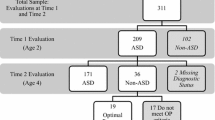Abstract
This study examines change in 152 children over an almost 10-year period (T1: 4.9 (±1.3) years; T2: 8.1 (±1.3) years; T3: 15(±1.6) years) using a group-based, semi-parametric method in order to identify distinct developmental trajectories. Important deficits remain at adolescence in the adaptive abilities of children with Autism spectrum disorders, but changes in adaptive skills show two distinct growth rates. The univariate analysis reveals that low growth trajectories for both social and communication outcome are associated with the following characteristics at age 5: low cognitive and language skills, presence of epilepsy, and severity of autism. The multivariate analysis confirms that risk factors at age 5, were low language and severity of autism for both social and communication outcomes 10 years later, and that hours of early intervention was protective factor for communication.


Similar content being viewed by others

References
Altiere, M. J., & Von Kluge, S. (2009). Searching for acceptance: Challenges encountered while raising a child with autism. Journal of Intellectual Disability Research, 34(2), 142–152.
Aman, M. G., Singh, N. N., Stewart, A. W., & Field, C. J. (1985). The aberrant behaviour checklist: A behavior rating scale for the assessment of treatment effects. American Journal on Mental Deficiency, 89, 485–491.
American Psychiatric Association (APA). (2000). Diagnostic and statistical manual of mental disorders, (4th ed., text revision). Washington, DC: American Psychiatric Association.
Anderson, D. K., Oti, R. S., Lord, C., & Welch, K. (2009). Patterns of growth in adaptive social abilities among children with ASD. Journal of Abnormal Child Psychology, 37(7), 1019–1034.
Baghdadli, A., Pascal, C., Grisi, S., & Aussilloux, C. (2003). Risk factors for self-injurious behaviours among 222 young children with autistic disorders. Journal of Intellectual Disability Research, 47(Pt 8), 622–627.
Baghdadli, A., Picot, M. C., Michelon, C., Bodet, J., Pernon, E., Burstezjn, C., et al. (2007). What happens to children with PDD when they grow up? Prospective follow-up of 219 children from pre-school age to mid-childhood. Acta Psychiatrica Scandinavica, 115(5), 403–412.
Beadle-Brown, J., Murphy, G., Wing, L., Gould, J., Shah, A., & Holmes, N. (2000). Changes in skills for people with intellectual disability: A follow-up of the Camberwell cohort. Journal of Intellectual Disability Research, 44, 12–24.
Bernheimer, L. P., Keogh, B. K., & Guthrie, D. (2006). Young children with developmental delays as young adults: Predicting developmental and personal–social outcomes. American Journal on Mental Retardation, 111, 263–272.
Brunet, O., & Lézine, I. (1975). Echelle de développement psychomoteur de la première enfance. In O. Brunet & I. Lézine (Eds.), Le développement psychologique de la première enfance (2e ed.). Paris: PUF.
Chadwick, O., Cuddy, M., Kusel, Y., & Taylor, E. (2005a). Handicaps and the developmental of skills between childhood and early adolescence in young people with severe intellectual disabilities. Journal of Intellectual Disabilities Research, 49, 877–888.
Chadwick, O., Kusel, Y., Cuddy, M., & Taylor, E. (2005b). Psychiatric diagnoses and behavior problems from childhood to early adolescence in young people with severe intellectual disabilities. Psychological Medicine, 35, 751–760.
Di Nuovo, S. F., & Buono, S. (2007). Psychiatric syndromes comorbid with mental retardation: Differences in cognitive and adaptive skills. Journal of Psychiatric Research, 41, 795–800.
Eaves, L. C., Wingert, H., & Ho, H. H. (2006). Screening for autism: Agreement with diagnosis. Autism, 10(3), 229–242.
Essex, E. L., Seltzer, M. M., & Krauss, M. W. (1999). Differences in coping effectiveness and well-being among aging mothers and fathers of adults with mental retardation. American Journal of Mental Retardation, 104(6), 545–563.
Gabriels, R. L., Ivers, B. J., Hill, D. E., Agnew, J. A., & McNeill, J. (2007). Stability of adaptive behaviours in middle-school children with autism spectrum disorders. Research in Autism Spectrum Disorders, 1(4), 293–303.
Howlin, P. (2003). Outcome in high-functioning adults with autism with and without early language delays: Implications for the differentiation between autism and Asperger syndrome. Journal of Autism and Developmental Disorders, 33(1), 3–13.
Howlin, P., Goode, S., Hutton, J., & Rutter, M. (2004). Adult outcome for children with autism. Journal of Child Psychology and Psychiatry, 45(2), 212–229.
Howlin, P., Mawhood, L., & Rutter, M. (2000). Autism and developmental receptive language disorder–a follow-up comparison in early adult life. Ii: Social, behavioural, and psychiatric outcomes. Journal of Child Psychology and Psychiatry, 41(5), 561–578.
Jacobson, J. W., & Ackerman, L. J. (1990). Differences in adaptive functioning among people with autism or mental retardation. Journal of Autism and Developmental Disorders, 20, 205–219.
Jonsdottir, S. L., Saemundsen, E., Asmundsdottir, G., Hjartardottir, S., Asgeirsdottir, B. B., Smaradottir, H. H., et al. (2006). Follow-up of children diagnosed with pervasive developmental disorders: Stability and change during the preschool years. Journal of Autism and Developmental Disorders, 37, 1361–1374.
Klin, A., Saulnier, C. A., Sparrow, S. S., Cicchetti, D. V., Volkmar, F. R., & Lord, C. (2007). Social and communication abilities and disabilities in higher functioning individuals with ASD: The Vineland and the ADOS. Journal of Autism and Developmental Disorders, 37(4), 748–759.
Leyfer, O. T., Folstein, S. E., Bacalman, S., Davis, N. O., Dinh, E., Morgan, J., et al. (2006). Comorbid psychiatric disorders in children with autism: Interview development and rates of disorders. Journal of Autism and Developmental Disorders, 36(7), 849–861.
Lord, C., Rutter, M., & Le Couteur, A. (1994). Autism diagnostic interview-revised: A revised version of a diagnostic interview for caregivers of individuals with possible pervasive developmental disorders. Journal of Autism and Developmental Disorders, 24(5), 659–685.
Matson, J. L., Dempsey, T., & Fodstad, J. C. (2009). The effect of autism spectrum disorders on adaptive independent living skills in adults with severe intellectual disability. Research in Developmental Disabilities, 30, 1203–1211.
Matson, J. L., Mayville, E. A., Lott, J. D., Bielecki, J., & Logan, R. (2003). A comparison of social and adaptive functioning in persons with psychosis, autism, and severe or profound mental retardation. Journal of Developmental and Physical Disabilities, 15, 57–66.
Mawhood, L., Howlin, P., & Rutter, M. (2000). Autism and developmental receptive language disorder–a comparative follow-up in early adult life. I: Cognitive and language outcomes. Journal of Child Psychology and Psychiatry, 41(5), 547–559.
McEachin, J. J., Smith, T., & Lovaas, O. I. (1993). Long term outcome for children with autism who received adult outcome of children with autism 227 early intensive behavioral treatment. American Journal of Mental Retardation, 97, 359–372.
McGovern, C. W., & Sigman, M. (2005). Continuity and change from early childhood to adolescence in autism. Journal of Child Psychology and Psychiatry, 46(4), 401–408.
Morgan, C. N., Roy, M., Nasr, A., Chance, P., Hand, M., et al. (2002). A community survey establishing the prevalence rate of autistic disorder in adults with learning disability. Psychiatric Bulletin, 26, 127–130.
Murphy, G. H., Beadle-Brown, J., Wing, L., Gould, J., Shah, A., & Holmes, N. (2005). Chronicity of challenging behaviors in people with severe intellectual disabilities and/or autism: A total population sample. Journal of Autism and Developmental Disorders, 35, 405–418.
Nagin, D. S., & Tremblay, R. E. (2001). Analyzing developmental trajectories of distinct but related behaviours: A group-based method. Psychological Methods, 6(1), 18–34.
O’Brien, S. (2001). Adult outcome of childhood learning disability. Developmental Medicine and Child Neurology, 43, 634–638.
Paul, R., Miles, S., Cicchetti, D., Sparrow, S., Klin, A., Volkmar, F., et al. (2004). Adaptive behaviour in autism and pervasive developmental disorder-not otherwise specified: Microanalysis of scores on the Vineland adaptive behaviour scales. Journal of Autism and Developmental Disorders, 34(2), 223–228.
Perry, A., Flanagan, H. E., Dunn Geier, J., & Freeman, N. L. (2009). Brief report: The Vineland adaptive behavior scales in young children with ASD at different cognitive levels. Journal of Autism and Developmental Disorders, 39(7), 1066–1078.
Schopler, E., Reichler, R., & Renner, B. (1986). The childhood autism rating scale-CARS. New York: Irvington.
Seibert, J. M., & Hogan, A. E. (1982). Procedures manual for early social communication scales (ESCS). FL: Mailman Center for Child Development, University of Miami.
Seltzer, M. M., Shattuck, P., Abbeduto, L., & Greenberg, J. S. (2004). Trajectory of development in adolescents and adults with autism. Mental Retardation Developmental Disability Research Review, 10(4), 234–247.
Shattuck, P. T., Seltzer, M. M., Greenberg, J. S., Orsmond, G. I., Bolt, D., Kring, S., et al. (2007). Change in autism symptoms and maladaptive behaviors in adolescents and adults with ASD. Journal of Autism and Developmental Disorders, 37(9), 1735–1747.
Shulman, B. (1985). Test of pragmatic skills. Tuscon, AZ: Communication Skill Builders.
Sparrow, S., Balla, D., & Cicchetti, V. (Eds.). (1984). Vineland adaptive behavior scales. Circle Pines, MN: American Guidance Service.
Spreckley, M., & Boyd, R. (2009). Efficacy of applied behavioral intervention in preschool children with autism for improving cognitive, language, and adaptive behavior: A systematic review and meta-analysis. Journal of Pediatrics, 154(3), 338–344.
Stern, W. (1912). The psychological methods of intelligence testing.
Szatmari, P., Bryson, S., Duku, E., Vaccarella, L., Zwaigenbaum, L., Bennett, T., et al. (2009). Similar developmental trajectories in autism and Asperger syndrome: From early childhood to adolescence. The journal of child psychology and psychiatry, 50(12), 1459–1467.
World Health Organization (WHO). (1993). ICD-10 classification of mental and behavioral disorders diagnostic criteria for research. Geneva: World Health Organization.
Yianni-Coudurier, C., Darrou, C., Lenoir, P., Verrecchia, B., Assouline, B., Ledesert, B., et al. (2008). What clinical characteristics of children with autism influence their inclusion in regular classrooms? Journal of Intellectual Disability Research, 52(10), 855–863.
Acknowledgments
This work was supported by grants from PHRC 1997 and 2006, and Orange Foundation, France. We thank Pr Fallissard and Dr Genolini for their helpful comments about statistics. The authors thank the children and their parents for their continued participation and support over the many years of this longitudinal study, as well as the clinical teams for their contribution to this research. Special thanks to the following research assistants who collected and coded the data: Camille Souche, Mehdi Liratni and Bérengére Sunyer. Finally, the authors thank John Salamon and Susan Orsoni for their careful reading of the manuscript.
Author information
Authors and Affiliations
Corresponding author
Rights and permissions
About this article
Cite this article
Baghdadli, A., Assouline, B., Sonié, S. et al. Developmental Trajectories of Adaptive Behaviors from Early Childhood to Adolescence in a Cohort of 152 Children with Autism Spectrum Disorders. J Autism Dev Disord 42, 1314–1325 (2012). https://doi.org/10.1007/s10803-011-1357-z
Published:
Issue Date:
DOI: https://doi.org/10.1007/s10803-011-1357-z



